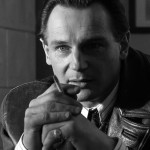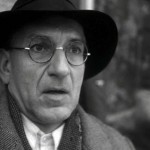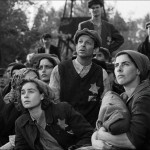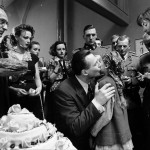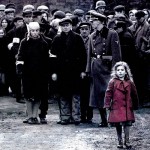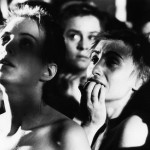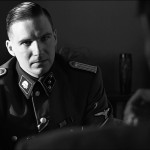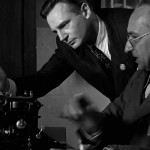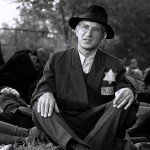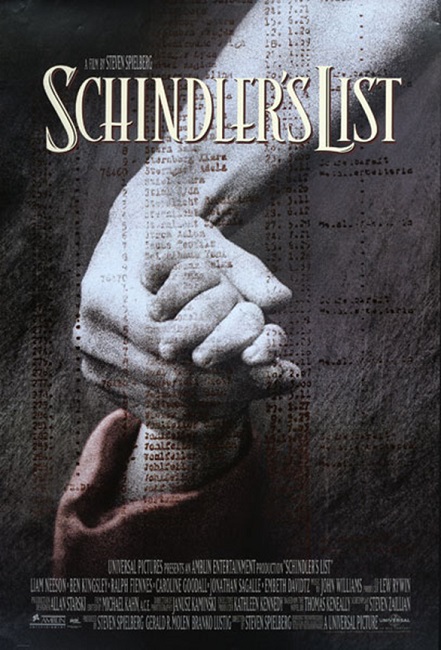
Schindler’s List – 1993
There is so much to say about this movie. Out of necessity, this is going to be a pretty long review. This winner, in my opinion, was one of the big ones, up there on a scale matching Gone With the Wind, and Ben-Hur. The film was huge in its sheer size and scope. It was also an important movie that has a very powerful message. But I must warn anyone who wants to see this movie: grab the hankies. It is an emotionally wrenching film.
How can it not be? It is, of course, about the Holocaust, and as such deals with some very disturbing and difficult subject matter in a graphic way that is sometimes very cold and dispassionate in the sense that it shows the atrocities of the Holocaust as they were carried out: very matter-of-factly. This movie portrays the utterly dehumanizing and unbelievably horrifying treatment of the Polish Jews living in Krakow during WWII. The movie was directed by Stephen Spielberg, a Jew himself. As such, the telling of the story which was based on real events was told with a great amount of passion and sensitivity.
Interesting note: The filming was done, as much as possible, in the actual locations where the real events took place. As such, most of the time there was a feeling of solemnness and depression on the set. The director felt the effects of this feeling very acutely. On several occasions, Robin Williams called Spielberg to cheer him up and offer him encouragement.
The main plot told the story of one man, a Nazi supporting German, named Oskar Schindler, played by Liam Neeson, an actor who was fairly unknown at the time. He attempted to re-create the real man, which he did with respect, and I could tell, a certain amount of rare humility. Neeson was incredible. He was nominated for the Best Actor award, though he did not win.
Schindler started out simply as a supporter of the Nazi Party, and why wouldn’t he be? The Nazis were his countrymen and the war was good for his business. He became a very rich man. But when he became a witness to the atrocities carried out by the Nazi soldiers against the Jews, he had a change of heart. He conceived of a plan to help the Jews in his own way. He used the money he earned, every last penny, to save as many lives as he could. He brought them in to his factory, using them as slave labor on the surface, but actually saving them from Nazi death camps. In doing so, he sometimes put himself under suspicion, but in that way he was able to save them.
In the end, he was only able to save just over 1,000 people, a relative few compared to the millions and millions of men, women and children who lost their lives. But the emotional climax of the film, which brought me to tears, was when the end of the war was announced and those he did save tried to thank him. All Schindler could to was break down into sobbing and tears because he had not been able to save more. Even now, I am getting misty–eyed just thinking about it. Neeson was incredible and really drove that scene home.
But the film was not just about him. The film was also a simple and honest testament to what happened, a statement that says we must never forget the truth, lest history be allowed to repeat itself. Spielberg filmed it in black and white for three very specific reasons that I feel need to be mentioned. First was that, as a director, he tried to be as objective about the subject matter as possible, even going so far as to make the film almost like a documentary. In the 1940s, black and white was still the normal and most common film format. Second, Spielberg said that the whole feel of the Holocaust was one of joylessness and death. Having the film done in black and white emphasized this feel in a way that a color film could not. And third, at four points in the film, color was used to show the importance and significance of a character or event.
The image of a three-year-old girl in a red coat wandering the streets during the Liquidation of the Krakow ghetto, one of several scenes in the movie that was horrifying to watch, was one of those four special scenes. The little girl, played by Oliwia Dabrowska, was supposed to be a symbolic figure. Spielberg said the scene was intended to symbolize how members of the highest levels of government in the United States knew the Holocaust was occurring, yet did nothing to stop it. I didn’t exactly get that from watching the film. However, I felt it was significant to the plot. Later, Schindler sees the girl on a cart of corpses. It a turning point for his character, the moment when, in his heart, he ceases to be a Nazi sympathizer, and starts his campaign to help the Jews.
Interesting note: Spielberg asked the young Dabrowska not to watch the film until she was an adult. However, she watched it when she was eleven, and was apparently “horrified” by the graphic content. But watching it again as an adult, she was mature enough to understand what she was watching and was proud of the role she played.
As with most films, there were plenty of sub-plots and separate stories that were told. The film also followed the lives of several Jewish families and people through the horrors of the war, and showed how they were saved by Schindler. Several actors and actresses stood out to me as incredibly good. Ben Kingsley, for one, who we remember from the 1982 Best Picture winner, Gandhi, played the part of Itzhak Stern. He was Schindler’s bookkeeper, and eventually his friend who helped him in his efforts to save as many Jews as possible. Kingsley turned in another great performance. He was real and believable, as he always seems to be. It was the character of Stern that actually typed the infamous list, dictated from Schindler, containing the names of Jews on whom the film is based.
Two women who did a fantastic job were Embeth Davidtz and Miri Fabian. Davidtz played the part of Helen Hirsch, a young Jewish girl who is forced to work as a housemaid to a vile Nazi monster, Amon Goeth, superbly played by Ralph Fiennes. (I’ll get to him in a bit.) He casually beat her and terrorized her according to his whims. The actress was incredible, portraying the constant fear that Hirsch felt during her time in Plaszow. Every day she lived with the knowledge that eventually, Goeth would murder her. The scene in which she confesses this fear to Schindler is a powerful scene.
Fabian played the part of Chaja Dresner, a Jewish mother who desperately tries to hold on to her children, which would have been near impossible to do. She goes from being the mother of a well-off family, to having everything stripped away, her possessions, her dignity, her family, and even her hair. She, and the women with her are dehumanized and brought to the brink of death. There is a scene in which the women are sent to Auschwitz. They see the black smoke pouring out of the chimney of the furnaces. They smell the stench of burning flesh. They are made to strip themselves naked and are herded into a shower room, not knowing what will come out of the shower-heads – water or lethal gas. Fabian, and the women with her, did such a great job. Their stories were heart-wrenching. They made me actually imagine myself in their shoes. What must it have been like? How would I have handled the fear?
Ralph Fiennes’s portrayal of Amon Goeth was incredible. I can’t even imagine how an actor can portray such a role without being emotionally affected. The character, based, of course on a real man, was accurately described as a monster. What he was, really, was a fanatic who believed so completely in Hitler and his ideals, that he, like Hitler, no longer saw the Jews as human beings. They were less than dirt. He would stand on his balcony at Plaszow with his rifle, using the Jews for target practice. Prisoners of the camp lived with the fear of instant and random death hanging over their heads. Fiennes was such a great actor, and I have to applaud him for a job well done. In the end, it was showed that he was hanged for his war crimes. Before the stool is kicked out from under his feet, he utters a very telling, “Heil Hitler,” showing just how much of a fanatic Goeth really was.
Interesting note: Ralph Fiennes actually looked very much like the real Amon Goeth, so much so that when one of the real Schindler Survivors, Mila Pfefferberg, was on the set and met him in his Nazi uniform, she actually trembled in fear.
As usual, when a film is based on actual events, I have to do a little research to find out if the film is loyal to the truth. How much was realistic, and how much was invented for the movie? This time, I really didn’t even need to look any further than the documentary that was included on the DVD. Several of the real survivors of the Holocaust were interviewed and told their stories. I watched and listened as the true facts came right from the mouths of the people who experienced it. Spielberg’s film was spot on. Every detail seemed to be adhered to. A man described seeing the women, who had been on a train separate from the men, as they arrived in Brinnlitz. He said that it was a night and it was foggy. The women almost seemed like ghosts as they got off the train and were marched into the barracks. Every one of those details was there in the film. Everything in the film seemed to be just like the Survivors described it.
Interesting note: A man who was interviewed told a story that was not covered in the film. He described his experience in the Polish military at the start of the war. He recounted his experience, marching out as part one of Poland’s first engagements with the German forces. They had no idea what they were up against. His regiment was massacred, starting with thousands, and ending with less than 300.
Now, I have to make special mention the music. John Williams does it again. But this time he got world famous violinist Itzhak Perlman to play the main theme. The music really is something special. The emotion that it evokes effortlessly tugs at the heart. Williams took home his fifth Oscar for Best Original Score, the others being Fiddler on the Roof, Jaws, Star Wars and E.T. the Extra-Terrestrial. Williams’ score was truly a work of art in itself and Perlman’s playing simply validated his status as one of the world’s greatest violinists.
There were so many powerful stories in the movie, and based on the documentary included with the DVD, they were portrayed pretty accurately, making them even more remarkable. Spielberg did a fantastic job of bringing them to life in a way that only he could. As a matter of fact, he was originally so daunted by the project that he tried to get other directors to take it. He offered it to Roman Polanski, Sydney Pollack, Martin Scorsese and Billy Wilder. But they each turned it down for similar reasons. Spielberg finally decided to do it himself when Holocaust deniers were being taken seriously by the media.
Interesting note: Studio Executive Sid Sheinberg green-lit the making of Schindler’s List on the condition that Spielberg first direct Jurassic Park. While Schindler’s List was being filmed in Poland, Spielberg spent several hours every night editing Jurassic Park.
Another interesting note: Schindler’s List was made on a budget of $22 million. Spielberg refused to accept a salary, calling it “blood money”, believing that he should not profit from the tragedy of the Jewish victims of the Holocaust. He believed that the film would flop.
Oskar Schindler was a man whose business ventures before and after WWII were largely unsuccessful. He actually died in poverty years later in Argentina, of all places. It was only during the war, when his fellow human beings needed the help that he was in a position to give, that his business thrived, enabling him to do what he did. I have heard his career described as one touched by divine intervention, a claim which is difficult to deny.
The emotional end of the film changes back to color, and shows a long line of real Holocaust survivors who were alive only because of Oskar Schindler. Beside them are the actors who portrayed them in the film. Together, they place stones on the grave of Schindler, who was interned in Israel. The final image before the credits start to appear is Neeson placing two red roses on the headstone which is now crowded with stones. It was a very emotional ending that left me in tears… again.
This was an incredible movie with some powerful performances, a profound and realistic script, a masterful score, and a deep, important message. But it is not one that I will be rushing out to watch again. It was depressing and difficult to watch, simply because it did not shy away from the evils that it portrayed. It showed in graphic detail, some of the darkest years in human history. As such, it made me reflect and turn my eyes inward, forcing me to embrace my own humanity.
